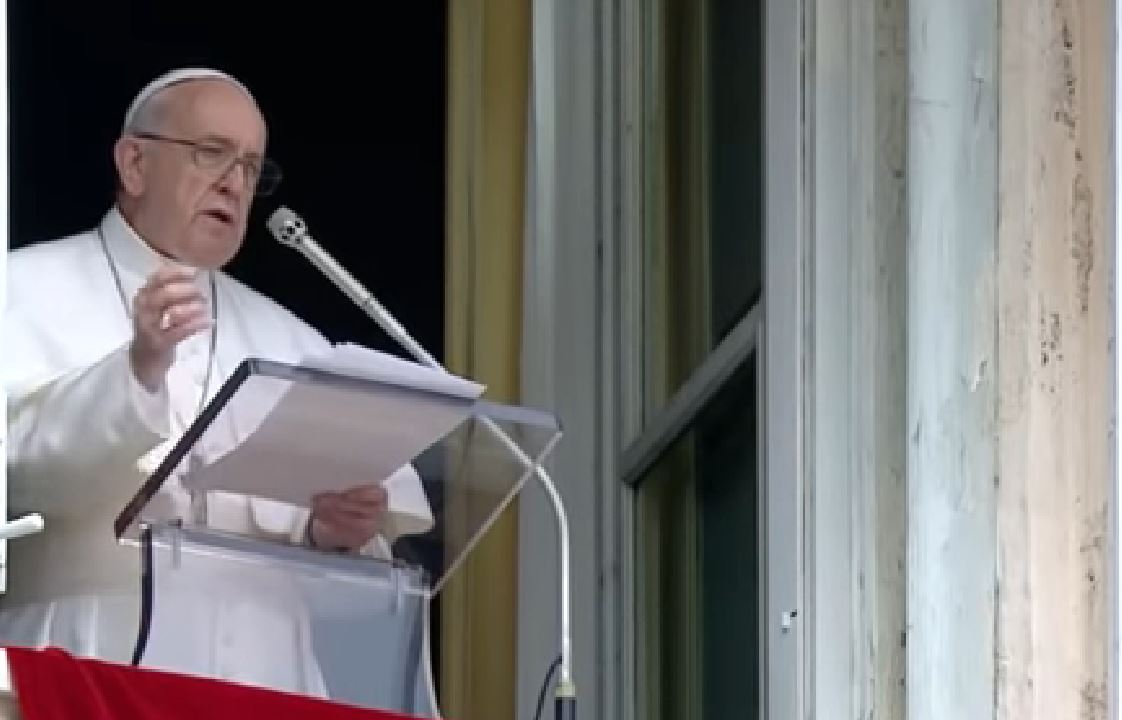Here is a translation of the address Pope Francis gave March 17, 2019, before and after praying the midday Angelus with those gathered in St. Peter’s Square.
* * *
Before the Angelus:
Dear Brothers and Sisters, good morning!
In this Second Sunday of Lent, the liturgy has us contemplate the event of the Transfiguration, in which Jesus grants the disciples Peter, James, and John to taste the glory of the Resurrection: a bit of Heaven on earth. The evangelist Luke (Cf. 9:28-36) shows us Jesus transfigured on the mountain, which is the place of light, fascinating symbol of the singular experience reserved to the three disciples. They go up the mountain with the Master, they see Him immerse Himself in prayer and, at a certain point, “the appearance of his countenance was altered” (v. 29). Used to seeing Him daily in the simple semblance of His humanity, in the face of this new splendor, which also envelops His whole person, they remain astonished. And Moses and Elijah appear next to Jesus, who speak with Him about His coming “exodus,” namely of His Paschal Death and Resurrection. It’s an anticipation of Easter. Then Peter exclaims: “Master, it is well that we are here” (v. 33). He wanted that moment of grace to be endless!
The Transfiguration happens at a very precise moment of Christ’s mission, namely, after He confided to the disciples that He would have “to suffer many things, [. . . ] be killed and on the third day be raised” (v. 21). Jesus knows that they don’t accept this reality — the reality of the cross, the reality of Jesus’ death –, and so He wants to prepare them to endure the scandal of <His> Passion and death on the cross, so that they know that this is the way through which the heavenly Father will have His Son attain to glory, resurrecting Him from the dead. And this will also be the way of the disciples: no one attains eternal life without following Jesus, without carrying one’s cross in earthly life. Each one of us has his/her own cross. The Lord makes us see the end of this course, which is Resurrection, beauty, after carrying one’s cross.
Therefore, Christ’s Transfiguration shows us the Christian perspective of suffering. Suffering isn’t sadomasochism: it’s a necessary but transitory passage. The point of arrival to which we are called is luminous as Christ’s transfigured countenance: in Him is salvation, beatitude, light and endless love of God. By showing His Glory in this way, Jesus assures us that the cross, the trials, the difficulties in which we find ourselves have their solution and their overcoming in Easter. Therefore, in this Lent, let us also go up the mountain with Jesus! But how? With prayer, we go up the mountain with prayer: silent prayer, heartfelt prayer, prayer that always seeks the Lord. We stay for a few moments in recollection, a bit every day, we fix our interior gaze on His face and we let His light pervade us and radiate in our life.
In fact, the evangelist Luke stresses that Jesus was transfigured “as He was praying” (v. 29). He was immersed in an intimate conversation with the Father, in which the Law and the Prophets also resounded — Moses and Elijah — and while He adhered with all His being to the Father’s Will of Salvation, including the cross, the glory of God invaded Him transpiring also outside. It’s so, brothers and sisters, the prayer in Christ and in the Holy Spirit transforms the person from inside and can illumine others and the surrounding world. How many times we have met persons that illumine, who emanate light from the eyes, who have that luminous look! They pray, and prayer does this: it makes us luminous with the light of the Holy Spirit.
We continue our Lenten itinerary with joy. We give space to prayer and to the Word of God, which the liturgy proposes abundantly to us in these days. May the Virgin Mary teach us to stay with Jesus even when we don’t understand Him and comprehend Him because only by remaining with Him we will see His glory.
[Original text: Italian] [ZENIT’s translation by Virginia M. Forrester]
© Libreria Editrice Vatican
After the Angelus:
Dear Brothers and Sisters,
Added in these days to the sorrow of the wars and conflicts, which don’t cease to afflict the whole of humanity, is that of the victims of the horrible attack against two Mosques in Christchurch, New Zealand. I pray for the dead and the wounded and their families. I’m close to our Muslim friends and to all that community. I renew the invitation to unite in prayer and, with gestures of peace, to oppose hatred and violence. Let us pray together, in silence, for our Muslim brothers who were killed.
A warm welcome goes to all of you present here: faithful of Rome and of so many parts of the world. I greet the pilgrims of Poland, those of Valencia in Spain, and those of Cajazeiras in Brazil and Benguela in Angola. How many Angolans!
I greet the parish groups from Verona, Quarto di Napoli and Castel del Piano of Perugia; the pupils of Corleone; the altar boys of Brembo in Dalmine and the “One to Hundred” Center of Padua.
I wish you all a happy Sunday. Please don’t forget to pray for me.
Enjoy your lunch and goodbye!
[Original text: Italian] [ZENIT’s translation by Virginia M. Forrester]
© Libreria Editrice Vatican

Vatican Media Screenshot
Angelus Address: On Christ’s Transfiguration and the Christian Perspective of Suffering
‘By Showing His Glory, Jesus Assures Us that the Cross, the Trials, the Difficulties, in which We Find Ourselves, Have their Solution in Easter’


